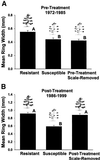Herbivory, plant resistance, and climate in the tree ring record: interactions distort climatic reconstructions
- PMID: 12110729
- PMCID: PMC126647
- DOI: 10.1073/pnas.152030399
Herbivory, plant resistance, and climate in the tree ring record: interactions distort climatic reconstructions
Abstract
To understand climate change, dendrochronologists have used tree ring analyses to reconstruct past climates, as well as ecological processes such as herbivore population dynamics. Such reconstructions, however, have been hindered by a lack of experiments that separate the influences of confounding impacts on tree rings, such as herbivores and the interactions of multiple factors. Our long-term experiments with scale insects on resistant and susceptible pines demonstrate three major points that are important to the application of this commonly used tool. (i) Herbivory reduced tree ring growth by 25-35%. (ii) The impact on ring growth distorted climate reconstruction, resulting in the overestimation of past moisture levels by more than 2-fold. Our data suggest that, if distortion because of herbivory has been a problem in previous reconstructions, estimates of the magnitude of recent climate changes are likely to be conservative. (iii) Our studies support a detectible plant resistance x herbivore x climate interaction in the tree ring record. Because resistance and susceptibility to herbivory are known to be genetically based in many systems, the potential exists to incorporate plant genetics into the field of dendrochronology, where it may be used to screen distortions from the tree ring record.
Figures




Similar articles
-
Genetic-Based Susceptibility of a Foundation Tree to Herbivory Interacts With Climate to Influence Arthropod Community Composition, Diversity, and Resilience.Front Plant Sci. 2018 Dec 11;9:1831. doi: 10.3389/fpls.2018.01831. eCollection 2018. Front Plant Sci. 2018. PMID: 30619404 Free PMC article.
-
[Influence of large volcanic eruptions on climate as revealed by tree-ring data on the Tibetan Plateau, China].Ying Yong Sheng Tai Xue Bao. 2021 Oct;32(10):3771-3780. doi: 10.13287/j.1001-9332.202110.009. Ying Yong Sheng Tai Xue Bao. 2021. PMID: 34676740 Chinese.
-
Sensitivity of ring growth and carbon allocation to climatic variation vary within ponderosa pine trees.Tree Physiol. 2012 Jan;32(1):14-23. doi: 10.1093/treephys/tpr112. Epub 2011 Nov 16. Tree Physiol. 2012. PMID: 22094578
-
Progress in Australian dendroclimatology: Identifying growth limiting factors in four climate zones.Sci Total Environ. 2016 Dec 1;572:412-421. doi: 10.1016/j.scitotenv.2016.08.096. Epub 2016 Aug 17. Sci Total Environ. 2016. PMID: 27543945 Review.
-
Identification, measurement and interpretation of tree rings in woody species from mediterranean climates.Biol Rev Camb Philos Soc. 2003 Feb;78(1):119-48. doi: 10.1017/s1464793102006000. Biol Rev Camb Philos Soc. 2003. PMID: 12620063 Review.
Cited by
-
Predictors of Ips confusus outbreaks during a record drought in southwestern USA: implications for monitoring and management.Environ Manage. 2010 Feb;45(2):239-49. doi: 10.1007/s00267-009-9413-6. Epub 2009 Dec 23. Environ Manage. 2010. PMID: 20033160 Free PMC article.
-
Drought negatively affects communities on a foundation tree: growth rings predict diversity.Oecologia. 2010 Nov;164(3):751-61. doi: 10.1007/s00442-010-1684-3. Epub 2010 Jun 26. Oecologia. 2010. PMID: 20582440
-
Genetic-Based Susceptibility of a Foundation Tree to Herbivory Interacts With Climate to Influence Arthropod Community Composition, Diversity, and Resilience.Front Plant Sci. 2018 Dec 11;9:1831. doi: 10.3389/fpls.2018.01831. eCollection 2018. Front Plant Sci. 2018. PMID: 30619404 Free PMC article.
-
Moving forward in global-change ecology: capitalizing on natural variability.Ecol Evol. 2012 Jan;3(1):170-81. doi: 10.1002/ece3.433. Epub 2012 Nov 29. Ecol Evol. 2012. PMID: 23404535 Free PMC article.
-
Tree genotypes affect rock lichens and understory plants: examples of trophic-independent interactions.Ecology. 2022 Feb;103(2):e03589. doi: 10.1002/ecy.3589. Epub 2021 Dec 17. Ecology. 2022. PMID: 34787902 Free PMC article.
References
-
- Douglas A E. Ecology. 1920;1:24–32.
-
- Fritts H C. Tree Rings and Climate. London: Academic; 1976.
-
- Fritts H C, Swetnam T W. Adv Ecol Res. 1989;19:111–188.
-
- Morrow P A, LaMarche V C. Science. 1978;201:1244–1246. - PubMed
Publication types
MeSH terms
LinkOut - more resources
Full Text Sources
Miscellaneous

